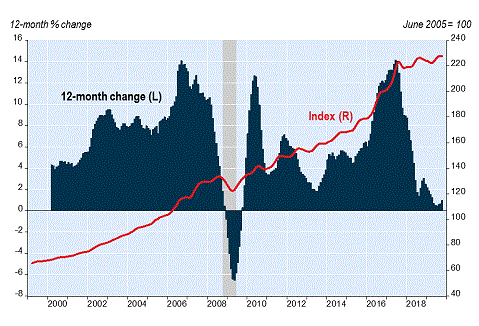

November 19, 2019
In October the Teranet–National Bank National Composite House Price IndexTM began the fourth quarter with a dip of 0.1% from the month before. The final quarter of the year is typically slow for the index, and the monthly decline was in line with the average of the last 10 Octobers, in five of which the index retreated. In short, it is too soon to herald a downward trend on the national home resale market. Indeed, if seasonal pressure were removed (seasonal adjustment), October would have been the third consecutive month of an underlying uptrend.
Pulling the composite down on the month were retreats in the indexes for Edmonton (−1.0%), Winnipeg (−0.4%), Toronto (−0.2%), Hamilton (−0.2%), Calgary (−0.1%) and Montreal (−0.1%). Pulling it up were Quebec City (0.1%), Vancouver (0.2%), Ottawa-Gatineau (0.2%), Victoria (0.7%) and Halifax (1.3%). For Vancouver it was a first monthly rise in 15 months, consistent with a strong revival of home sales since August. For Ottawa-Gatineau, October was the seventh consecutive monthly rise, for a cumulative surge of 9.8%. Victoria has also had a good run, with gains in six of the last seven months. For Halifax it was the 10th advance in 12 months. For Toronto, on the other hand, October ended a run of six monthly rises. Same story for the five-month runs of Montreal and Winnipeg. According to the most recent data, however, the resale market remains balanced in Toronto and favourable to sellers in Montreal.

Despite October’s drop, the composite index has strengthened over the last six months after weakness in the previous six months, a history reflected in a cumulative gain of only 1.0% for the 12 months ending in October. That, however, amounts to a third consecutive acceleration. The 12-month change was braked by the three largest western markets – Vancouver (down 6.2% from a year earlier), Edmonton (−3.4%) and Calgary (−1.7%). The change from a year earlier was marginally upward for Winnipeg (0.3%), Victoria (0.7%) and Quebec City (1.0%), more firmly upward in Toronto (4.1%), Hamilton (4.5%), Montréal (6.0%), Ottawa-Gatineau (7.7%) and Halifax (8.3%).
Besides the Toronto and Hamilton indexes included in the composite index, indexes exist for the seven other urban areas of the Golden Horseshoe. In general the 12-month movement of these indexes has been roughly similar to those of Toronto and Hamilton, with recoveries beginning in the second quarter of the year after a period of weakness. All were up from a year earlier, some strongly: Oshawa 1.8%, Barrie 3.1%, Brantford 5.6%, Peterborough 6.8%, Guelph 6.8%, Kitchener 7.3% and St. Catharines 7.7%.
Indexes not included in the composite index also exist for seven markets outside the Golden Horseshoe. Of the two in B.C., Abbotsford-Mission has struggled over the last 12 months (−2.8%) while Kelowna (+2.2%) has been recovering for seven months. Of the five in Ontario, Windsor (9.8%) and London (9.1%) have done well over the whole 12 months, while the recovery of recent months has been spectacular in Thunder Bay (up 6.6% from a year earlier), Kingston (6.1%) and Sudbury (4.6%).
For the full report including historical data, please visit www.housepriceindex.ca.







